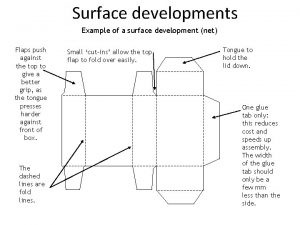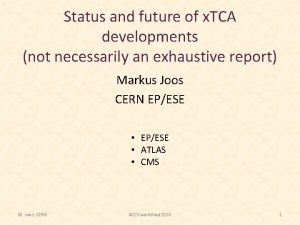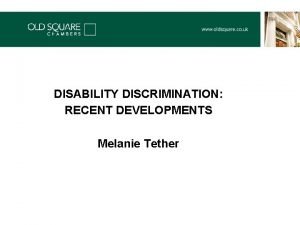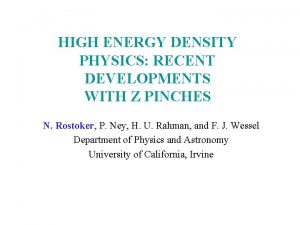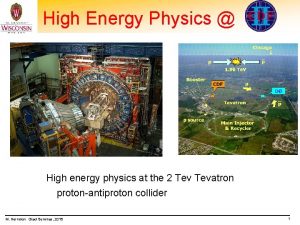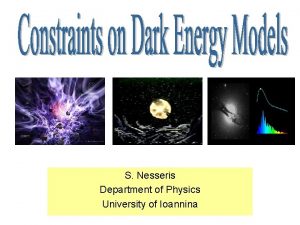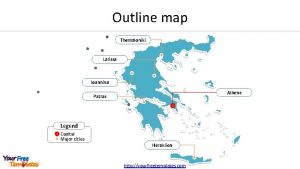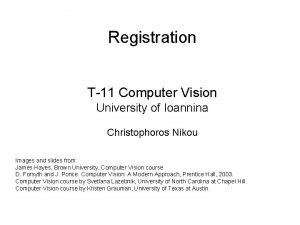IOANNINA 2005 Recent Developments in High Energy Physics





















- Slides: 21

IOANNINA 2005, Recent Developments in High Energy Physics and Cosmology. Brane world models with a scalar field non -minimally coupled with gravity Pavlos Pasipoularides-NTUA K. Farakos and P. Pasipoularides 1) Phys. Lett. B 621 (2005) 224 -232 (hep-th�504014). 2) hep-th�602200

EXTRA DIMESIONS: A WAY TO EXTEND FOUR-DIMENSIONAL CONVENTIONAL PHYSICS An important issue in multidimensional-theories is the mechanism by which extra dimensions are hidden, so that space-time is effectively four-dimensional insofar as known physics is concerned. Two mechanisms are available: q. Kaluza q. Brane Klein scenario (Compact extra dimensions) world scenario (Localization of ordinary matter on the brane)

BRANE WORLD SCENARIO v v According to brane world scenario, ordinary matter is trapped into a three dimensional submanifold (brane world) that is embedded in a fundamental multidimensional manifold (bulk). Only gravitons can leave in the bulk. This scenario allows the extra dimensions to be large or even infinite. Brane world models predict new phenomenology even at Te. V scale, and put on a new basis fundamental problems such as the hierarchy problem and the cosmological constant problem. Bulk z (extra dimension) Bulk Brane

LOCALIZATION OF ORDINARY MATTER ON THE BRANE 1) Domain Wall Mechanism (Only Localization of Fermions on the Brane) 2) Layer Phase Mechanism (or Dvali-shifman mechanism). Localization of extended structures of particles, Gauge fields-fermions and Bosons with gauge charge. Higss phase G’ Confinement phase G

There are two characteristic Brane world models with gravity n n FLAT EXTRA DIMENSIONS: ADD Model (Arkani. Hammed, Dimopoulos and D’vali). Large compact extra dimensions (R~160μm). WARPED EXTRA DIMENSIONS: First (Large compact extra dimensions) and Second (Infinite extra dimension) RANDALL-SUNDRUM Models

RS 2 -MODEL This is a single brane model with an infinite extra dimension z. We have a brane with positive tension σ, and a bulk with a negative fivedimensional cosmological constant Λ. Junction condition Ad. S 5 around the brane and effectively Minkowski space on the brane

RS 1 -MODEL: Two-Brane setup We have a five dimensional space with an orbifolded (S 2/Z 2) fifth dimension z of radius zc which takes values in the interval [0, πzc]. We consider two branes at the fixed (end) points z=0 and z= πzc with tensions σ and –σ. The particles of the standard model are assumed to be localized on the negative tension brane which is called SM or visible brane. The positive tension brane is called Planck or hidden

In our work we have studied numerically a variation of the RS 2 -MODEL with a bulk scalar field non-minimally coupled with gravity. The motivation is the construction of a brane world model where the Layer-Phase mechanism is induced by gravity.

Einstein Equations including the bulk field

Equations of motion We are looking for Static Solutions of the form

BOUNDARY CONDITIONS Two Junction Conditions One Constraint for the first derivatives

We have to integrate numerically two second order differential equations with appropriate boundary conditions on the brane According to the value of ξ we obtain three classes of solutions, with different features.

First class of solutions Large ξ=-0. 1, λ=0. 01, σ=6, Λ=-6

First class of solutions Small ξ=-0. 001, λ=0. 01, σ=6, Λ=-6

Violation of the fine-tuning

Second class of solutions ξ=1+ξc, λ=0. 1

Second class of solutions ξ=1+ξc, λ=0. 01 This class of solutions incorporates a gravity-induced layer-phase mechanism for the localization of ordinary particles on the brane.

Third class of solutions ξ=0. 1, λ=0. 01, σ=6, Λ=-6

Solutions in the case of Conformal coupling ξ=ξc

Conclusions: We studied the RS 2 -model with a nonminimally coupled bulk scalar field (V(Φ)=λΦ^4). According to the values of ξ we obtained three classes of solutions 1) 2) ξ<0: The solutions suffer from naked singularity in the bulk. ξ>ξc: The warp factor increases exponentially for large z, whereas the scalar field is nonzero on the brane and tends rapidly to zero in the bulk. This implies a layer phase mechanism for the localizations of ordinary particles on the brane. 3) 0<ξ<ξc: The warp factor increases faster than the second case, whereas the scalar field tends rapidly to infinity. ξ=0: The solutions are of the form of class (1) ξ=ξc: The solutions are of the form of class (2) 4) 5)

We have also examined the stability of Solutions n n n The first (ξ<0, ξ=0) and second class (0<ξ<ξc) of solutions are unstable against scalar field perturbations, due to the existence of a continuous spectrum of tachyon modes. The third class of solutions (ξ>ξc) are stable against scalar field perturbations. The solutions in the case of conformal coupling (ξ=ξc) are stable against scalar field perturbations. For this reason this class of solutions is physically interesting.
 Recent developments in ict
Recent developments in ict Recent developments in object detection
Recent developments in object detection A friend emails you the results
A friend emails you the results Energy energy transfer and general energy analysis
Energy energy transfer and general energy analysis Energy energy transfer and general energy analysis
Energy energy transfer and general energy analysis Cultural developments of sahelanthropus tchadensis
Cultural developments of sahelanthropus tchadensis Chartered developments
Chartered developments Political developments in the early republic
Political developments in the early republic Huron creek developments reviews
Huron creek developments reviews Political developments in the early republic
Political developments in the early republic Surface developments
Surface developments Gte milano
Gte milano In the colonial era developments such as the new england
In the colonial era developments such as the new england Target developments
Target developments Definition pattern of development examples
Definition pattern of development examples Two types of pattern development
Two types of pattern development Asis atca
Asis atca Democratic developments in england
Democratic developments in england Cplim
Cplim Name of prism
Name of prism Medical developments international penthrox
Medical developments international penthrox American grassfed association standards
American grassfed association standards










